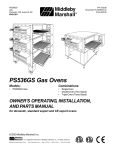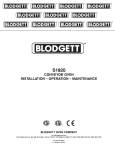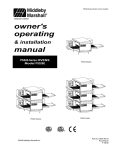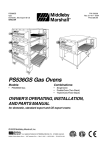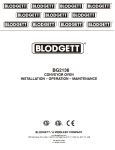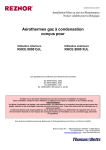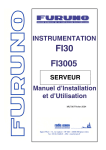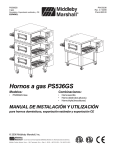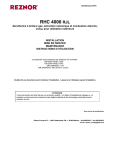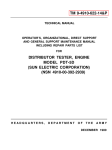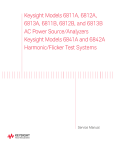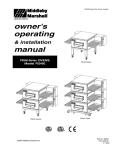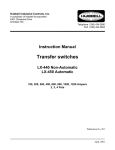Download Middleby Marshall PS520G User's Manual
Transcript
Middleby
Marshall
PS520-Series Gas Ovens: English
October 17, 2006
®
A MIDDLEBY COMPANY
owner's
operating
& installation
manual
PS520-Series OVENS
Model PS520G
PS520 (Double)
©2006 Middleby Marshall Inc.
PS520 (Single)
PS520 (Triple)
Part No. 59223
Price $30.00
P: 10/06
NOTICE:
This Owner's Operating and Installation Manual should be given to the user. The operator of the oven should
be familiar with the functions and operation of the oven.
This manual must be kept in a prominent, easily reachable location near the oven.
Ovens are shipped from the factory configured for use with natural gas. If permitted by local, national and
international codes, at the time of installation the oven may be converted to propane gas operation. This
conversion requires the use of at Gas Conversion Kit that is supplied with the oven. For CE-approved ovens,
the conversion is described in the Installation section of this Manual. For domestic and standard export ovens,
instructions are included in the Gas Conversion Kit.
It is suggested to obtain a service contract with a Middleby Marshall Authorized Service Agent.
WARNING
POST, IN A PROMINENT LOCATION, THE EMERGENCY TELEPHONE NUMBER OF YOUR LOCAL
GAS SUPPLIER AND INSTRUCTIONS TO BE FOLLOWED IN THE EVENT YOU SMELL GAS.
Instructions to be followed in the event the user smells gas shall be obtained by consulting the local gas
supplier. If the smell of gas is detected, immediately call the emergency phone number of your local Gas
Company. They will have personnel and provisions available to correct the problem.
WARNING
FOR YOUR SAFETY, DO NOT STORE OR USE
GASOLINE OR OTHER FLAMMABLE VAPORS AND
LIQUIDS IN THE VICINITY OF THIS OR ANY OTHER
APPLIANCE.
WARNING
Improper installation, adjustment, alteration, service, or
maintenance can cause property damage, injury, or
death. Read the installation, operation, and maintenance
instructions thoroughly before installing or servicing this
equipment.
NOTICE
The warranty is NOT VALID unless the oven is installed, started, and
demonstrated under the supervision of a factory-authorized installer.
NOTICE
Contact your authorized Service Agency to perform maintenance and
repairs. A Service Agency Directory is supplied with your oven.
NOTICE
Using any parts other than genuine Middleby Marshall factory-manufactured
parts relieves the manufacturer of all warranty and liability.
NOTICE
Middleby Marshall (Manufacturer) reserves the right to
change specifications at any time.
KEEP THIS MANUAL IN A VISIBLE LOCATION NEAR THE OVEN
FOR FUTURE REFERENCE.
ii
Model No.
Modéle No.
Serial No.
Serié No.
Installation Date
Date d'installation
MIDDLEBY MARSHALL
NO QUIBBLE LIMITED WARRANTY
(U.S.A. ONLY)
MIDDLEBY MARSHALL INC.
OVEN LIMITED WARRANTY
(Non U.S.A.)
The Seller warrants equipment manufactured by it to be free from
defects in material and workmanship for which it is responsible. The
Seller’s obligation under this warranty shall be limited to replacing or
repairing, at Seller’s option, without charge, F.O.B. Seller’s factory,
any part found to be defective and any labor and material expense
incurred by Seller in repairing or replacing such part. Such warranty
is limited to a period of one year from date of original installation or
15 months from date of shipment from Seller’s factory, whichever is
earlier, provided that terms of payment have been fully met. All labor
shall be performed during regular working hours. Overtime premium
will be charged to the Buyer.
MIDDLEBY MARSHALL, HEREINAFTER REFERRED TO AS
“THE SELLER”, WARRANTS EQUIPMENT MANUFACTURED
BY IT TO BE FREE FROM DEFECTS IN MATERIAL AND
WORKMANSHIP FOR WHICH IT IS RESPONSIBLE. THE
SELLER’S OBLIGATION UNDER THIS WARRANTY SHALL
BE LIMITED TO REPLACING OR REPAIRING, AT SELLER’S
OPTION, WITHOUT CHARGE, ANY PART FOUND TO BE
DEFECTIVE AND ANY LABOR AND MATERIAL EXPENSE
INCURRED BY SELLER IN REPAIRING OR REPLACING
SUCH PART. SUCH WARRANTY SHALL BE LIMITED TO
THE ORIGINAL PURCHASER ONLY AND SHALL BE EFFECTIVE FOR A PERIOD OF ONE YEAR FROM DATE OF ORIGINAL INSTALLATION, OR 18 MONTHS FROM DATE OF PURCHASE, WHICHEVER IS EARLIER, PROVIDED THAT TERMS
OF PAYMENT HAVE BEEN FULLY MET.
This warranty is not valid unless equipment is installed, started,
and demonstrated under the supervision of a factory-authorized installer.
Normal maintenance functions, including lubrication, adjustment of
airflow, thermostats, door mechanisms, microswitches, burners
and pilot burners, and replacement of light bulbs, fuses and indicating lights, are not covered by warranty.
This warranty is valid only if the equipment is installed, started,
and demonstrated under the supervision of a factory-authorized installer.
Any repairs or replacements of defective parts shall be performed by
Seller’s authorized service personnel. Seller shall not be responsible for any costs incurred if the work is performed by other than
Seller’s authorized service personnel.
Normal maintenance functions, including lubrication, cleaning, or customer abuse, are not covered by this no quibble
warranty.
When returning any part under warranty, the part must be intact and
complete, without evidence of misuse or abuse, freight prepaid.
Seller shall be responsible only for repairs or replacements
of defective parts performed by Seller’s authorized service
personnel. Authorized service agencies are located in principal cities throughout the contiguous United States, Alaska,
and Hawaii. This warranty is valid in the 50 United States
and is void elsewhere unless the product is purchased
through Middleby International with warranty included.
Seller shall not be liable for consequential damages of any kind
which occur during the course of installation of equipment, or which
result from the use or misuse by Buyer, its employees or others of
the equipment supplied hereunder, and Buyer’s sole and exclusive
remedy against Seller for any breach of the foregoing warranty or
otherwise shall be for the repair or replacement of the equipment or
parts thereof affected by such breach.
The foregoing warranty is exclusive and in lieu of all other
warranties, expressed or implied. There are no implied
warranties of merchantability or of fitness for a particular purpose.
The foregoing warranty shall be valid and binding upon Seller if and
only if Buyer loads, operates and maintains the equipment supplied
hereunder in accordance with the instruction manual provided to
Buyer. Seller does not guarantee the process of manufacture by
Buyer or the quality of product to be produced by the equipment
supplied hereunder and Seller shall not be liable for any prospective
or lost profits of Buyer.
The foregoing shall be Seller’s sole and exclusive obligation
and Buyer’s sole and exclusive remedy for any action, including breach of contract or negligence. In no event shall
Seller be liable for a sum in excess of the purchase price of
the item. Seller shall not be liable for any prospective or lost
profits of Buyer.
THE FOREGOING WARRANTY IS EXCLUSIVE AND IN LIEU OF
ALL OTHER EXPRESS AND IMPLIED WARRANTIES WHATSOEVER. SPECIFICALLY THERE ARE NO IMPLIED WARRANTIES
OF MERCHANTABILITY OR OF FITNESS FOR A PARTICULAR
PURPOSE.
This warranty is effective on Middleby Marshall equipment sold on, or after, February 15, 1995.
The foregoing shall be Seller’s sole and exclusive obligation and
Buyer’s sole and exclusive remedy for any action, whether in breach
of contract or negligence. In no event shall seller be liable for a sum
in excess of the purchase price of the item.
© 2003 - Middleby Marshall, A Middleby Company.
The Middleby Marshall logo is a registered trademark of Middleby Marshall, A Middleby Company.
Middleby Marshall Inc. • 1400 Toastmaster Drive • Elgin, Illinois 60120-9272 U.S.A. • (847) 741-3300 • FAX: (847) 741 4406
iii
TABLE OF CONTENTS
TABLE OF CONTENTS
(Continued)
Page
SECTION 1
I. MODEL IDENTIFICATION .............................................. 1
SERIES PS520 GAS SPECIFICATIONS ............................ 2
II. COMPONENT FUNCTION ............................................. 4
A. Conveyor Motor and Conveyor Belt ........................ 4
B. Blower Fan ................................................................. 4
C. Gas Burner ................................................................ 4
D. Cooling Fan ................................................................ 4
E. Air Fingers and Blank Plates - See Figure 1-9 ........ 4
SECTION 2
I. UNLOADING ................................................................... 8
PARTS LIST FOR SERIES PS520 GAS OVEN
INSTALLATION KIT .................................................... 8
UTILITY ROUGH-IN DIMENSIONS AND POSITIONING
FOR PS520-SERIES OVENS .................................... 13
CIRCUIT BREAKER ..................................................... 13
ELECTRICAL SPECIFICATIONS ................................. 13
ELECTRICAL RATING ................................................. 13
SUPPLY WIRE .............................................................. 13
SUGGESTED ................................................................ 13
II. VENTILATION GUIDELINES ........................................ 13
III. ELECTRICAL CONNECTION INFORMATION FOR
PS520-SERIES OVENS. ........................................... 14
IV. ELECTRIC SUPPLY FOR GAS HEATED OVENS ..... 14
V. GAS SUPPLY .............................................................. 15
SECTION 3 INSTALLATION
I. CONTROL FUNCTIONS ................................................ 17
II. COMPONENT INFORMATION AND LOCATION ......... 18
A. Door Safety Switch .................................................. 18
B. Blower Switch .......................................................... 18
C. Heat Switch .............................................................. 18
D. Temperature Controller .......................................... 18
E. Conveyor ................................................................. 19
MEASURING CONVEYOR SPEED. ............................. 19
Page
III. STEP-BY-STEP OPERATION ....................................... 20
A. Startup Procedures ................................................. 20
Daily Startup ................................................................. 20
Power Failure ............................................................... 20
B. Shutdown Procedure ............................................... 20
IV. NORMAL OPERATION - STEP-BY-STEP ................... 22
A.Daily Startup Procedure ........................................... 22
B. Daily Shutdown Procedure ...................................... 22
V. QUICK REFERENCE: TROUBLESHOOTING ............ 24
SECTION 4 MAINTENANCE
I. MAINTENANCE - DAILY ............................................ 26
A. Exterior ..................................................................... 26
B. Cooling Fan ............................................................... 26
C. Conveyor Belt .......................................................... 26
D. Crumb Pans ............................................................. 26
II. MAINTENANCE - MONTHLY ....................................... 27
A. Removing Conveyor From Oven For Cleaning ..... 27
B. Air Fingers Disassembly For Cleaning .................. 29
C. Reassembly of Air Fingers ..................................... 30
D. Reinstall End Plugs ................................................. 33
E. Conveyor Reassembly Into Oven .......................... 34
F. Checking Conveyor Belt Tension ........................... 34
G. Conveyor Belt Link Removal ................................. 35
H. Attaching Drive Chain ............................................. 36
III. MAINTENANCE - EVERY 3 MONTHS ......................... 37
A. Electrical Terminals ................................................ 37
B. Ventilation ................................................................ 37
IV. MAINTENANCE - EVERY 6 MONTHS ........................ 37
PS520-SERIES GAS OVEN KEY SPARE
PARTS ....................................................................... 38
KEY SPARE PARTS KIT ............................................... 38
SECTION 5 TROUBLESHOOTING
Troubleshooting Charts ...................................................... 39
SECTION 6 ELECTRICAL SCHEMATICS
Wiring Diagram, G208-240V 50/60 GO, PS520 ............... 41
NOTE
Wiring Diagrams are in Section 6 of this Manual.
The diagram for each oven is also on the lower
inner surface of its Control Console.
iv
SECTION 1
DESCRIPTION
SECTION 1
DESCRIPTION
I.
MODEL IDENTIFICATION
The Middleby Marshall PS520-Series may be used either
as a single oven or stacked for use as double or triple
ovens.
A single PS520-Series Oven (Figure 1-1) is mounted on a
base pad with legs. A double oven (Figure 1-2) consists of
two, stacked, single ovens. A triple oven (Figure 1-3)
consists of three stacked single ovens. The lower oven is
mounted on a base pad with stacking pins.
On a double or triple oven, the ovens operate independently. All ovens use identical controls and components.
One oven can be cleaned or serviced, while the others are
operating.
Figure 1-1. Single PS520 Oven
Figure 1-2. Double PS520 Oven
Figure 1-3. Triple PS520 Oven
1
SECTION 1
DESCRIPTION
PS520 SERIES OVEN SPECIFICATIONS
Conveyor Belt Width
Heating Zone Length
Baking Area Square Feet
Overall Dimension – Standard Single Oven w/Legs
18.00″ (457mm)
20.00″ (5098mm)
2.5 sq. ft. (0.23 sq. m.)
42.00″ (1067mm) L ×
35.21″ (894mm) W ×
21.10″ (536mm) H ×
42.00″ (1067mm) L ×
35.21″ (894mm) W ×
36.64″ (931mm) H x
42.00″ (1067mm) L x
35.21″ (894mm) W ×
48.19″ (1224mm) H ×
250 lb (93.3kg)
325 lb (121.3kg)
22.1 ft3 (0.62 m3)
8.3 kW/hr
40,000 BTU/HR
1/2″ NPT
600°F (316°C)
20 min.
1-10 minutes
Overall Dimension – Double Oven
Overall Dimension – Triple Oven
Weight of Single Oven
Shipping Weight
Shipping Cube
Operating Range
BTU's – Natural or Propane Gas
Gas Input – Natural or Propane Gas
Maximum Operating Temperature
Warm-up Time
Belt Speed Limits
SERIES PS520 ELECTRICAL SPECIFICATIONS
Main Blower &
Elements Voltage
Control Circuit
Voltage
Phase
Frequency
Amperage
Draw
Poles
Wires
208-240V
208-240V
1 Ph
50/60 Hz
1.5 Amp
2 Pole
3 Wire
(2 hot, 1 grd)
GAS ORIFICE AND PRESSURE SPECIFICATIONS (PER OVEN CAVITY) - DOMESTIC AND STANDARD EXPORT OVENS
Gas Type
Supply (Inlet) Pressure
Orifice (Manifold)
Pressure
0.073” (2.0574mm, #49 drill)
6-12” W.C. (14.9-29.9mbar) *
3.5” W.C. (8.72mbar)
0.052” (1.85mm, #55 drill)
11-14” W.C. (27.4-34.9mbar) *
7” W.C. (17.44mbar)
Main Orifice I.D.
Bypass Orifice I.D.
Natural
0.082” (2.08mm, #45 drill)
Propane
0.057” (1.45mm, #46 drill)
* The gas supply pressures and orifice sizes shown are for ovens installed in North America. The required gas supply pressures and orifice
sizes of ovens installed in other locations are dependent on the local gas type and on all applicable local codes.
GAS ORIFICE AND PRESSURE SPECIFICATIONS (PER OVEN CAVITY) - CE OVENS
Supply (Inlet) Pressure
Main
Orifice
dia.
IT,PT,ES,SE,
UK,CH,IT,AT,
DK,FI
I2H
DE
I2E
BE,FR
I2E+
G20
2.3749
mm
20
mbar
20
mbar
20
mbar
--
G25
2.3749
mm
--
--
--
G30
1.3970
mm
--
--
--
Gas
Type
SE,CH,AT,DK, BE,IE,IT,PT,
FI,DE,NL
ES,UK
I3B/P
I3+
Orifice
(Manifold)
Pressure
Rated
Heat
Input
--
11.21
mbar
22.36
kW-hr.
--
--
16.19
mbar
22.36
kW-hr.
29 or 50
mbar
28-30, 37
or 50 mbar
26.2
mbar
22.59
kW-hr.
NOTE
Wiring Diagrams are contained in Section 6 of this Manual
and are also located inside the oven at the
bottom of the Control Panel.
Additional electrical information is provided on the oven's serial plate.
This Manual Must Be Kept For Future Reference.
2
SECTION 1
DESCRIPTION
II. COMPONENT FUNCTION (Figure 1-4)
Figure 1-4. PS520-Series Oven Components Locations
3
SECTION 1
DESCRIPTION
II. COMPONENT FUNCTION
A. Conveyor Motor and Conveyor Belt
The conveyor belt is driven by a variable-speed electric
motor (Figure 1-5) operating through a gear reducer. The
motor speed is controlled by a digital control. The stainless-steel wire belt can travel in either direction at variable
rates ranging from 3 minutes to 30 minutes; this is the time
that a product can take to pass through the oven.
B. Blower Fan
The blower fans are located at the rear of the oven. These
blowers force heated air through the air fingers. The
BLOWER switch must be set to “ON” or “I” for oven
warmup and baking.
C. Gas Burner
The gas burner is located inside the rear panel and is
controlled by the temperature controller.
D. Cooling Fan — See Figure 1-5 and Figure 1-6
Blower Assembly
The cooling fan is located in the back of the oven. The
cooling fan draws air through its grille, blowing it through
the blower motor compartment and the control compartments into the oven top and exhausted out the front
louvers.
E. Air Fingers and Blank Plates - See Figure 1-7
E1. Air Fingers
An Air Finger Assembly is made up of three parts:
1. Outer Plate - The Outer Plate is the removable covering
with tapered holes, which direct the air stream onto the
product being baked.
2. Inner Plate -The perforated Inner Plate is vital in forming
the unique air jets. It must be assembled into the manifold
with its holes aligned with the holes of the outer plate.
3. Manifold - The Manifold is the assembly which slides
on tracks into the oven plenum.
Right Control Box
Figure 1-5. Machinery Compartment
Components
4
SECTION 1
DESCRIPTION
Figure 1-6. Cooling Fan
5
SECTION 1
DESCRIPTION
F2. Blank Plates
1. Blank Plates- The Blank Plates are available to install
on the plenum where an air finger is not required.
Half Blank Plate
Outer Plate
Blank Plate
Inner Plate
Finger
Manifold
Assembly
Baffle
Figure 1-7. Blank Plates (two sizes) and an Air Finger.
6
SECTION 2
INSTALLATION
SECTION 2
INSTALLATION
WARNING - For gas ovens, after any conversions, readjustments, or service work on the oven:
• Perform a gas leak test.
• Test for correct air supply.
• Test for proper combustion and gas supply.
• Check that the ventilation system is in operation.
WARNING
Keep the appliance area free and clear of combustibles.
WARNING
The oven must be installed on an even (level) non-flammable flooring and any adjacent walls must
be non-flammable. Recommended minimum clearances are specified in the Description section of
this Manual.
WARNING
Do not obstruct the flow of combustion and ventilation air to and from your oven. There must be no
obstructions around or underneath the oven. Constructional changes to the area where the oven is
installed shall not affect the air supply to the oven.
CAUTION
For additional installation information, contact your local Authorized Service Agent.
NOTE
There must be adequate clearance between the oven and combustible construction. Clearance
must also be provided for servicing and for proper operation.
NOTE
An electrical wiring diagram for the oven is located inside the machinery compartment.
NOTE
All aspects of the oven installation, including placement, utility connections, and ventilation requirements,
must conform with any applicable local, national, or international codes. These codes supersede the
requirements and guidelines provided in this manual.
NOTE
In the USA, the oven installation must conform with local codes. In the absence of local codes, gas oven
installations must conform with the National Fuel Gas Code, ANSI Z223.1. Installed ovens must be
electrically grounded in accordance with local codes, or in the absence of local codes, with the National
Electrical Code (NEC), or ANSI/NFPA70.
NOTE
In Canada, the oven installation must conform with local codes. In the absence of local codes, gas oven
installations must conform with the Natural Gas Installation Code, CAN/CGA-B149.1, or the Propane Gas
Installation Code, CAN/CGA-B149.2, as applicable. Installed ovens must be electrically grounded in
accordance with local codes, or in the absence of local codes, with the Canadian Electrical Code CSA C22.2.
NOTE
In Australia, the oven installation must conform with any requirements of the appropriate statutory authority.
Gas oven installtions must conform with AGA Codes AG311 and AG601.
NOTE
In CE countries, all aspects of the gas supply connection must comply with current IEC/CEE requirements and
with all applicable local, national, and international codes. In addition, four casters are provided to allow the oven
to be more easily moved to the installation location. These casters are intended to simplify pre-installation
movement only, and are NOT suitable for use as part of a CE oven installation. During the installation procedure,
the casters MUST be removed, so that the oven can be supported by the supplied 152mm adjustable legs.
7
SECTION 2
INSTALLATION
NOTE: The oven, when installed, must be electrically
grounded in accordance with local codes, or in the absence of local codes, with the National Electrical Code
(NEC), or ANSI/NFPA70.
I. UNLOADING
Your Middleby Marshall PS520-Series Oven is shipped
partially assembled. It will arrive in a carton on a crate.
Carton size for a PS520-Series Oven is:
NOTE
44-1/4″ (1124mm) Long ×
There must be adequate clearance between
the oven and any adjacent combustible construction. Clearance must also be provided
for servicing and for operation.
37-1/2″ (953mm) Wide ×
23″ (584mm) High ×
The crate and carton must be examined before signing the
Bill of Lading. Report any visible damage to the transport
company, and check for the proper number of crates. If
apparent damage is found, make arrangements to file a
claim against the carrier. Surface Interstate Commerce
Regulations (U.S.A.) require that the claim must be
initiated by the consignee within 10 days from the date that
the shipment is received.
CAUTION
It is recommended that the oven be placed under
a ventilation hood for adequate air supply and
ventilation.
CAUTION
Do not obstruct the flow of ventilation air to and
from your oven. Do not obstruct the fan holes in
the rear of the unit.
ITEM
NO.
1
2
3
4
5
6
7
8
PARTS LIST FOR SERIES PS520 GAS OVEN
INSTALLATION KIT
Single Stack Oven
P/N 59182
QTY
4
2
1
1
4
1
1
1
PART NO.
3101908
48392
48394
48396
51387
59223
22450-0228
22361-0001
DESCRIPTION
LEG 4″ AD FT
INSULATION BOTTOM TRAY
BOTTOM TRAY WELDMENT
TOP COVER
SCREW MSSLT THREAD 8-32 × 1/2, 18-8
OWNER'S OPERATING & INSTALLATION MANUAL
GAS HOSE RESTRAINT CABLE
GAS HOSE
7
8
Figure 2-1. PS520-Series Gas Oven Installation Parts
8
SECTION 2
INSTALLATION
ITEM
NO.
1
2
3
4
5
6
7
8
PARTS LIST FOR SERIES PS520 Gas OVEN
INSTALLATION KIT
Double Stack Oven
P/N 59183
QTY
2
1
1
4
4
1
1
2
PART NO.
48392
48394
48396
51387
3101908
59223
22450-0228
22361-0001
DESCRIPTION
INSULATION BOTTOM TRAY
BOTTOM TRAY WELDMENT
TOP COVER
SCREW MSSLT THREAD 8-32 × 1/2, 18-8
LEG 4″ AD FT
OWNER'S OPERATING & INSTALLATION MANUAL
GAS HOSE RESTRAINT CABLE
GAS HOSE
7
8
ITEM
NO.
1
2
3
4
5
6
7
8
PARTS LIST FOR SERIES PS520 Gas OVEN
INSTALLATION KIT
Triple Stack Oven
P/N 59184
QTY
2
1
1
4
4
1
1
3
PART NO.
48392
48394
48396
51387
M3828
59223
22450-0228
22361-0001
DESCRIPTION
INSULATION BOTTOM TRAY
BOTTOM TRAY WELDMENT
TOP COVER
SCREW MSSLT THREAD 8-32 × 1/2, 18-8
PIN, ALIGNMENT
OWNER'S OPERATING & INSTALLATION MANUAL
GAS HOSE RESTRAINT CABLE
GAS HOSE
7
8
Figure 2-1 (continued). PS520-Series Gas Oven Installation Parts
9
SECTION 2
INSTALLATION
Figure 2-5. MODEL PS520 SINGLE OVEN DIMENSIONS
1
4.00
101.6mm
1
The Opening Height is Adjustable from 2-1/4 inch minimum
to 3-3/4 inch maximum in 1/2 inch increments.
10
SECTION 2
INSTALLATION
Figure 2-6. MODEL PS520 DOUBLE OVEN DIMENSIONS
1
4.00
101.6mm
1
The Opening Height is Adjustable from 2-1/4 inch minimum
to 3-3/4 inch maximum in 1/2 inch increments.
2
P/N 59927 is shown in its correct installed position.
11
SECTION 2
INSTALLATION
Figure 2-7. MODEL 520 TRIPLE OVEN DIMENSIONS
1
1
The Opening Height is Adjustable from 2-1/4 inch minimum
to 3-3/4 inch maximum in 1/2 inch increments.
2
P/N 59927 is shown in its correct installed position.
12
SECTION 2
INSTALLATION
UTILITY ROUGH-IN DIMENSIONS AND POSITIONING
FOR PS520-SERIES OVENS
WARNING
DO NOT USE CONDUIT OR GAS LINE
FOR GROUND CONNECTION.
CAUTION
IT IS RECOMMENDED THAT THE OVEN
BE PLACED UNDER A VENTILATION
HOOD FOR ADEQUATE AIR SUPPLY
AND VENTILATION.
ELECTRIC SUPPLY TO BE
PROVIDED BY CUSTOMER
CIRCUIT BREAKER
Figure 2-9. Typical PS520-Series Oven(s)
Installation
Separate circuit breaker with lockout/tagout electrical
shutoff for each oven. Wire each oven separately.
POWER RATING
40,000 BTU/hr (11.7 kW/hr.
SUPPLY WIRE
Supply wire size must be in accordance with the National
Electrical Code (current edition) and must be in compliance with local codes.
SUGGESTED
15A Amp circuit breaker for 208-240V.
ELECTRICAL SPECIFICATIONS
DOMESTIC: 208V main blower motors, 1 Ph, 1.5 Amp
draw, 50/60 Hz, 208-240V control circuit, 2 pole, 3 wire
system per oven (2 hot, 1 grd).
Do NOT use conduit for ground.
or
If space permits, service should be located near the
control console end of the oven(s) to allow convenient
access to safety switches.
DOMESTIC or EXPORT: 240V main blower motors, 1 Ph,
1.5 Amp draw, 50/60 Hz, 208-240V control circuit, 2 pole,
3 wire system per oven (2 hot, 1 grd).
CAUTION
230V main blower motors, 1 Ph, 1.5 Amp draw, 50/60 Hz,
208-240V control circuit, 2 pole, 3 wire system per oven
(2 hot, 1 grd).
UNIT MUST HAVE AIR VENT PLATES INSTALLED OR WARRANTY WILL BE VOID.
Do NOT use conduit for ground.
II. VENTILATION GUIDELINES
A mechanically driven ventilation system is required for the
PS520 Series Middleby Marshall conveyorized gas ovens.
Local codes and conditions vary greatly from one area to
another and must be complied with. Following are the
suggested requirements for good ventilation. Please remember these are recommendations or guidelines, you
may have a special condition or problem that will require
the services of a ventilation engineer or specialist. Proper
ventilation is the oven owner’s responsibility. Improper
ventilation can inhibit oven performance.
Please Note: There are now two “stand off”
‘C’ Channels and the “plate” for “Double
and Triple Ovens” that must be installed in
the field.
13
SECTION 2
INSTALLATION
These ‘C’ Channel brackets are installed in the vertical
plane using existing screws (Item 6) to support these ‘C’
Channels using the upper and lower Key Hole openings in
the ‘C’ Channels. The ‘C’ Channels are identical and once
installed will allow ample amounts of air through the cooling
fan mounted on the rear side of the oven by keeping the
oven away from the rear wall.
electrical code requirements. Copper is the recommended
material for the electrical supply conductors.
IV. ELECTRIC SUPPLY FOR GAS
HEATED OVENS
Power requirements for gas heated ovens are 208 240VAC, 1-phase, 3-wire (2 ‘hot’, 1 ground). Electrical
connection is made through a cord and plug. Using flexible
cable(s) for the electrical power supply conductors requires a 2″ (51mm) strain-relief fitting (not furnished) to
enable safe access to the terminal block from which oven
power is distributed.
III. ELECTRICAL CONNECTION INFORMATION
FOR PS520-SERIES OVENS.
The supply conductors must be of the size and
material (copper) recommended to provide the current required; (refer to the data plate for the ampere
specifications). The electric current rating for each
conductor supplying a PS520-Series Oven is 1.5A.
WARNING
Authorized supplier personnel normally accomplish the connections for the ventilation
system, electric and gas supplies, as arranged by the customer. Following these
connections, the factory-authorized installer
can perform the initial startup of the oven.
Check the oven data plate (Figure 2-10) before making any
electric supply connections. Electric supply connections
must agree with data on the oven data plate.
NOTE: The electric supply installation must satisfy the
requirements of the appropriate statutory authority, such
as the National Electrical Code (NEC), ANSI/NFPA70,
(U.S.A.); the Canadian Electrical Code, CSA C22.2; the
Australian Code AG601; or other applicable regulations.
ELECTRICAL
INLET
A fused disconnect switch or a main circuit breaker
(customer furnished) MUST be installed in the electric
supply line for each oven; it is recommended that this
switch/ circuit breaker have lockout/tagout capability. The
electric supply connection must meet all national and local
GAS INLET
Figure 2-11. Junction Connection Box
Figure 2-10. Typical Electric Oven Data Plate
14
SECTION 2
INSTALLATION
V. GAS SUPPLY
CAUTION
DURING PRESSURE TESTING NOTE THE FOLLOWING:
1. The oven and its individual shutoff valve must be disconnected from the gas supply piping system during any
pressure testing of that system at test pressure in excess
of 1/2 psi (3.45 kPa).
2. The oven must be isolated from the gas supply piping
system by closing its individual manual shutoff valve during any pressure testing of the gas supply piping system
at test pressure equal to or less than 1/2 psi (3.45 kPa).
3. If incoming pressure is over 14″″ W.C. (35mbar), a
separate regulator MUST be installed in the line BEFORE
the individual shutoff valve for the oven.
WARNING: To prevent damage to the control valve regulator during initial turn- on of gas, it is very important to
open the manual shutoff valve very slowly.
After the initial gas turn-on, the manual shutoff valve must
remain open except during pressure testing as outlined in the
above steps or when necessary during service maintenance.
A.
Gas Utility Rough-In Recommendations
The following gas system specifications are STRONGLY
RECOMMENDED. Deviating from these recommendations
may affect the baking performance of the oven.
Gas Meter - 650 cfh (307l/min) meter
Gas Line
•
DEDICATED LINE from the gas meter to the oven
•
1-1/2" (50.8mm) pipe for natural gas
•
1-1/2″ (38.1mm) pipe for propane
•
Maximum length: 200' (61m). Each 90° elbow equals 7'
(2.13m) of pipe.
B.
Gas Conversion
Ovens are shipped from the factory configured for use with
natural gas. If permitted by local, national and international
codes, the oven may be converted to propane gas operation
using a Gas Conversion Kit that is supplied with the oven. Gas
orifice sizes supplied with the Kit match those shown in the
Tables on page 2 in the Description section of this Manual.
NOTE: Certain safety code requirements exist for the installation
of gas ovens; refer to the beginning of Section 2 for a list of the
installation standards. In addition:
•
In the USA, the installation must conform with local codes,
or in the absence of local codes, with the National Fuel Gas
Code, ANSI Z223.1.
•
In Canada, the installation must conform with local codes,
or in the absence of local codes, with the Natural Gas
Installation Code, CAN/CGA-B 149.1, or the Propane
Installation Code, CAN/CGA-B 149.2, as applicable.
•
In Australia, the installation must conform with AGA Codes
AG311 and AG601, and with any requirements of the
appropriate statutory authority.
•
In CE countries, the gas supply connection should be
according to EN-203 (gas appliance directive) and to
applicable ISO 228-1 or ISO 7-1 recommendations. All
aspects of the gas supply connection must comply with
current IEC/CEE requirements and with all applicable
local, national, and international codes.
•
For all ovens equipped with casters, the gas line connection
shall be made with:
A connector that complies with the Standard for
Connectors for Movable Gas Appliances, ANSI Z21.69
(in USA), or Connectors for Movable Gas Appliances,
CAN/CGA-6.16 (in Canada).
Check the oven’s gas supply requirements to determine the
type of gas to be used with the oven. If the gas type required does
NOT match the local supply:
•
For North American installations, a conversion kit is
supplied with the oven to allow operation using propane
gas. Refer to Part B, Gas Conversion, in this section.
•
For CE ovens, directions for converting the oven for use with
other gases are described in Part D.1, Preparation for Use
with Various Gases, in this section.
If the installation will use the supplied gas hose, be sure that
the 1/2″ to 3/4″ gas line fitting is attached. Refer to the
instructions in the gas hose package. One gas line connection
method is shown in Figure 2-12; however, compliance with the
applicable standards and regulations is mandatory.
Inlet and regulated gas pressures can be measured using a “U” tube
manometer at the tap locations shown in Figures 2-12 and 2-13.
Figure 2-12 - Flexible Gas Hose Installation
Where permitted by local and national codes, it is possible to
convert ovens from natural to propane gas, or from propane to
natural gas, after the oven has been installed. Gas Conversion
Kits are available from Middleby Marshall for this purpose.
C.
1/2" gas
pipe nipple
3/4"-1/2"
gas pipe
reducer
Connection
WARNING
Some procedures in this section may require conversions,
readjustments, or service on the oven's gas system. Before
performing these procedures, check that the main
gas supply valve and the circuit breaker/fused disconnect are in the OFF (“O”) position. After completing
these procedures, perform a gas leak test before operating
the oven.
To Gas
Supply
Pipe
3/4" gas
pipe nipple
1/2" gas line
tee with
pressure tap
90°
Elbow
Full-Flow
Gas
Shutoff
Valve
CAUTION
The terms of the oven's warranty require all start-ups, conversions and service work to be performed by a Middleby Marshall
Authorized Service Agent. The installation, start-up and changes
required when changing from one gas type to another can be
performed ONLY by a certified professional.
Quickdisconnect
device
15
Flexible
Gas Hose
Individual gas
connection for
each oven
cavity
SECTION 2
INSTALLATION
1.
Checking the Gas Supply (Inlet) Pressure
a.
With the main gas supply valve closed and the circuit
breaker/fused disconnect in the OFF (“O”) position, open
the inlet pressure tap shown in Figure 2-13 and attach a
manometer to the tap.
b.
Depress the safety switches to allow the oven to operate.
c.
Open the main gas supply valve. Switch the circuit breaker/
fused disconnect to the ON (“I”) position.
d.
Start the oven according to the directions in the Operation
section of this Manual. Adjust the temperature controller to
the maximum setting 600°F (316°C).
e.
Measure the supply (inlet) pressure.
f.
Switch the oven off. Close the main gas supply valve, and
switch the circuit breaker/fused disconnect to the OFF (“O”)
position. Remove the manometer, and close the inlet tap.
b.
Volumetric Method
1.
Determine the time of 0.1m3 (100 liters) of gas usage
as follows.
Consumption (m3/hr.) =
NB (Rated input in kW)
HuB (Heat [Calorific] value
of gas in kW/m3)
Time (in minutes) of
=
0.1m3 of gas usage
6
Consumption
2.
Check that the main gas supply valve and the circuit
breaker/fused disconnect are in the OFF (“O”) position.
3.
Remove the cap screw from the pressure adjustment
screw (governor) on the gas control valve.
4.
Depress the safety switches to allow the oven to operate.
5.
If the supply pressure is lower or higher than the nominal
pressure, the reason should be investigated and the gas
supplier contacted.
Open the main gas supply valve. Switch the circuit
breaker/fused disconnect to the ON (“I”) position.
6.
For natural gas ovens, if the measured supply pressure is lower
than 3.5″ wc, or higher than 7″ wc, contact the gas supplier. DO
NOT OPERATE THE OVEN or adjust the oven controls.
Start the oven according the directions in the Operation
section of this Manual. Adjust the temperature controller
to the maximum setting (316°C).
7.
Adjust the pressure adjustment screw as necessary
to match the calculated volume using the time (in
minutes) of 0.1m 3 of gas usage. Turning the
adjustment screw clockwise increases the flow, while
turning it counterclockwise reduces the flow.
8.
Record the reading obtained from the gas meter and
calculate the obtained gas flow. Compare this value
to the information in the tables in the Description
section of this Manual.
9.
Switch the oven off. Close the main gas supply valve,
and switch the circuit breaker/fused disconnect to the
OFF (“O”) position. Replace the cap screw onto the
gas control valve.
g.
2.
Compare the measured supply (inlet) pressure to the
nominal pressures shown in the Description section of
this Manual.
Adjusting the Orifice (Manifold) Pressure and Heat Input
To use the orifice pressure method, you must know the specific
gas type and quality used. If using the orifice pressure method,
you should double-check the input using the volumetric method.
To use the volumetric method, you must know the heat value
(HuB) of the gas used. This information is available from your
gas supplier.
During these measurements, do not operate any other
appliances that use the same gas meter as the oven.
a.
Orifice (Manifold) Pressure Method
1.
With the main gas supply valve closed and the circuit
breaker/fused disconnect in the OFF (“O”) position,
open the manifold pressure tap shown in Figure 2-13
and attach a manometer to the tap.
2.
Remove the cap screw from the pressure adjustment
screw (governor) on the gas control valve.
3.
Depress the safety switches to allow the oven to operate.
4.
Open the main gas supply valve. Switch the circuit
breaker/fused disconnect to the ON (“I”) position.
5.
Start the oven according the directions in the Operation
section of this Manual. Adjust the temperature controller
to the maximum setting (316°C).
6.
Adjust the pressure adjustment screw as necessary
to match the correct pressure for the oven's specific
gas type. Refer to the Pressure Table in the Description
section of this Manual. Turning the adjustment screw
clockwise increases the flow, while turning it
counterclockwise reduces the flow.
7.
Switch the oven off. Close the main gas supply valve,
and switch the circuit breaker/fused disconnect to the
OFF (“O”) position. Remove the manometer, and
close the manifold pressure tap.
16
Figure 2-13 - Gas Control Valve
Pressure
adjustment
screw
(under cap)
Mainfold
pressure tap
(where regulated
gas pressure is
measured)
SECTION 3
OPERATION
SECTION 3
OPERATION
I. CONTROL FUNCTIONS
Figure 3-1. PS520-Series Oven Control Functions
WARNING
A possibility of injury from rotating parts and
electric shock exists in this oven.
Never disassemble or clean the oven with the
BLOWER switch or any other oven control turned
“ON” or “I”. Turn “OFF” or “O” and lockout or
tagout all electric power to the oven before
attempting to clean or service this oven.
17
SECTION 3
OPERATION
If the temperature inside the oven is over 180°F (82°C)
the main blower will continue to run after the blower
switch is turned to the “OFF” or “O” position.
II. COMPONENT INFORMATION AND
LOCATION (Figures 3-1 and 3-2)
A. Door Safety Switch
C. Heat Switch
The Door Safety Switch is located at the lower right side
of control panel opening. Opening the control panel door
permits this switch to open, disconnecting power to all
electrical controls.
The “Heat Switch” allows the burner to activate. Activation
is determined by the settings on the Digital Temperature
Controller.
D. Temperature Controller
CAUTION
The temperature controller is a solid-state, PID type to
maintain the operator-set temperature. The temperature
controller continuously monitors the oven temperature and
turns on the modulating solid state relay controller. The
heat is on for the time required to maintain a constant oven
temperature.
Do NOT touch the wires going to this safety switch.
Current is always present.
B. Blower Switch
The temperature controller contains a low-limit switch
which allows the oven to cool down to 200°F (93°C) before
shutting off the blower. A high-limit indication (ALM 1) will
appear on the display if the oven reaches 650°F (343°C).
The blower switch has two positions. The switch must
be “ON” or “I” for the main blowers to come on and permit
the oven to run. The fan circulates the air throughout the
oven and must stay on during baking and during the
cool down cycle above 200°F (93°C) to prevent blower
bearing damage. To protect the blower motor and
bearings a thermostatic override is built into the oven.
Figure 3-2. Interior View of Control Console
18
SECTION 3
OPERATION
E. Conveyor
The on-off switch for the conveyor motor is on the control
panel. Also on the control panel is the digital conveyor
speed control. The digital control can be adjusted
from 1-10 min. bake time (conveyor speed).
Refer to Figure 3-3.
Conveyor speed is measured by the amount of time it
takes for an item to go through the bake chamber of the
oven.
MEASURING CONVEYOR SPEED.
See Figures 3-4 and 3-5.
Figure 3-3. Conveyor Speed Digital Control
To check conveyor speed, place a product item at the
entrance end of baking chamber as shown. Time how long
it takes for the leading edge of the item to go from the
entrance end of the baking chamber to the exit end. This
should be the conveyor speed shown on the conveyor
speed digital control.
NOTE: In Figures 3-4 and 3-5, the oven shown is with the
conveyor running right to left.
WARNING
Possibility of injury from rotating parts and
electrical shock exist in this oven.
Never disassemble or clean the oven with the
blower switch or any other part of the oven
turned “ON” or “I”. Turn “OFF” or “O” and
lockout or tagout all electrical power to the
oven before attempting to clean or service
this oven.
Figure 3-4. Product at entrance end of baking
chamber – BEGINNING OF TIMING
Figure 3-5. Product at exit end of baking
chamber – END OF TIMING
19
SECTION 3
OPERATION
WARNING
4. Set the temperature controller to the desired baking
temperature.
OVEN MUST BE KEPT CLEAR OF
COMBUSTIBLES AT ALL TIMES.
NOTE: For complete temperature controller operation
instructions refer to Step C.
5. Turn the HEAT switch (Figure 3-6) to the “ON” or “I”
position. Wait for the “Heat ON” light to turn on.
III. STEP-BY-STEP OPERATION
6. Oven will reach a baking temperature of 500°F (232°C)
in approximately 20 minutes. Allow the oven to cycle for
30 minutes after it has reached desired bake temperature.
The oven is now ready for baking.
A. Startup Procedures
Daily Startup
1. Turn the BLOWER switch (Figure 3-6) to the “ON” or “I”
position. This starts the main blower fan and the cooling
fans. The blower circulates air through the air fingers and
must stay on during the cooking or baking process.
Power Failure
In case of power failure, turn off all switches and remove
product. After power has been reestablished follow
normal startup procedure.
2. Check to see if the cooling fans (see Figure 1-8) are
operating when the blower switch (see Figure 3-6) is turned
“ON” or “I”. The cooling fans cool the control components
and blower motor. The cooling fans, located at the rear of
the oven blows air into and through the cabinet. Air is
exhausted through the front of the cabinet and also out the
front of the oven. Refer to Daily Maintenance Section for
fan intake checking procedure.
B. Shutdown Procedure
1. Turn the BLOWER and HEAT switches to “OFF” or “O”.
NOTE: The blowers will remain on until the oven temperature cools down to 200°F (93°C) at which time they will stop
automatically.
2. Make certain that there are no products left on the
conveyor inside the oven. Turn the CONVEYOR switch
to “OFF” or “O”.
IMPORTANT NOTE
The cooling fan operates when the BLOWER
switch is turned “ON” or “I”. It must operate to keep
the control console below 140°F (60°C).
3. Turn the CONVEYOR switch (Figure 3-6) to the “ON” or
“I” position. This starts the conveyor belt moving through
the oven. Set the conveyor speed for the desired baking
time. Refer to the following Procedures E, F and G.
20
SECTION 3
OPERATION
Figure 3-6. Control Panel
21
SECTION 3
OPERATION
IV. NORMAL OPERATION - STEP-BY-STEP
7.
Wait for the oven to heat to the setpoint temperature.
Higher setpoint temperatures will require a longer wait.
The oven can reach a temperature of 500°F (232°C) in
approximately 15 minutes.
8.
(Optional) Press the Tem-
A.Daily Startup Procedure
1.
Check that the circuit breaker/fused disconnect is in the
on position.
2.
Turn the "BLOWER"
(
) switch to the “ON”
("I") position.
3.
Turn the "CONVEYOR"
(
) switch to the
“ON” ("I") position.
4.
5.
If necessary, adjust the
conveyor speed setting
by pressing the
or
pushbuttons on the conveyor speed controller to
change the displayed
bake time.
Adjust the temperature
controller to a desired set
temperature, if necessary.
•
•
6.
perature ( ) key to show
the Actual Temperature
in the display, and wait
for the "ACTUAL TEMP"
light to turn on. This allows you to monitor the
oven temperature as it
rises to the setpoint.
Press the Up Arrow
and Down Arrow
Keys as necessary
to adjust the setpoint.
9.
Allow the oven to preheat for 10 minutes after it has
reached the set point temperature.
B.
DAILY SHUTDOWN PROCEDURE
1.
Turn the "HEAT" ( ) and
"BLOWER" ( ) switches to the "OFF" ("O")
position. Note that the
blowers will remain in operation until the oven has
cooled to below 200°F
(93°C).
2.
Make certain that there
are no products left on
the conveyor inside the
oven. Turn the "CON) switch to
VEYOR" (
the "OFF" ("O") position.
3.
After the oven has cooled and the blowers have turned
to the “OFF” or “O” position, switch the circuit breaker/fuse
disconnect to the “OFF” or “O” position.
or
+
wait
for
Press the Set Point
and Unlock keys at
the same time. Wait
for the "SET PT" light
to turn on.
or
wait
for
+
IMPORTANT
On gas ovens, if the "HEAT ON" light will not illuminate,
OR if the oven does not heat, the gas burner may not have
lit. Turn the "HEAT" ( ), "BLOWER" ( ), and "CONVEYOR" (
) switches to the "OFF" ("O") position. Wait
for AT LEAST FIVE MINUTES before restarting the oven.
Then, repeat the Daily Startup procedure.
Turn the "HEAT" ( )
switch to the "ON" ("I")
position, and wait for the
"HEAT ON" light to turn
on.
CAUTION
In case of power failure, turn all switches to the “OFF”
("O") position and remove the product. After the
power has been restored, perform the normal startup
procedure. IF THE OVEN WAS SWITCHED OFF FOR
LESS THAN 5 MINUTES, WAIT FOR AT LEAST FIVE
wait
for
MINUTES BEFORE RESTARTING THE OVEN.
22
SECTION 3
OPERATION
"HEAT ON"
Light
Display
Shows the Set Point
or the Actual Temperature in degrees
Fahrenheit (F) or
Celsius (C).
Lights when the
burner is in
operation.
"SP LOCK"
Light
Lights when the
set point is locked
out from changes.
This setting can
only be changed by
service personnel.
"SET PT"
(setpoint)
Light
Lights when the
set point is shown
in the display.
OVERTEMP
Light
"ACTUAL TEMP"
Light
Lights when the oven
temperature is
greater than 650°F
(343°C). Refer to
Quick Reference:
Troubleshooting in
this section.
Lights when the Actual
Temperature is shown
in the display.
Service Key
Temperature
Key
Service use
only.
Press this key once
to view the Actual
Temperature in the
Display.
Set Point Key
Unlock Key
Press this key
together with the Set
Point Key to allow the
Set Point to be
changed. Changes
can only be made for
60 seconds.
Up Arrow and Down
Arrow Keys
Press these keys to
adjust the Set Point up or
down. If the Set Point will
not change, refer to Set
Point Key and Unlock Key
in this section.
23
Press this key
together with the
Unlock Key to allow
the Set Point to be
changed.
Changes can only be
made for 60 seconds.
SECTION 3
OPERATION
V. QUICK REFERENCE: TROUBLESHOOTING
SYMPTOM
light is lit, food product is
undercooked
Oven will not
turn on at all
PROBLEM
The oven temperature exceeded 650°F (343°C), and
the burner was automatically shut down.
•
Follow the procedures under Daily Shutdown Procedures in
this section to shut down the oven. Contact your Middleby
Marshall Authorized Service Agent to determine and correct the
cause of the condition to prevent damage to the oven.
Electrical power may not be
reaching the oven, or the
controls may be set incorrectly.
•
Check that the circuit breaker/fused disconnect is turned on.
•
Check that the "BLOWER"
position.
The oven did not reach
200°F (93°C) within 15 minutes of startup, and the oven
has stopped heating.
•
Turn the "HEAT" ( ), "BLOWER" ( ), and "CONVEYOR"
(
)switches to the "OFF" ("O") position.
•
Wait for AT LEAST FIVE MINUTES before restarting the oven.
•
Repeat the Daily Startup procedure.
Controls may be set incorrectly.
•
Check that the Set Point is correctly set.
•
Check that both the "BLOWER" (
are in the “ON” ("I") position.
•
If the oven still will not heat,turn the "HEAT" ( ), "BLOWER"
(
), and "CONVEYOR" (
)switches to the "OFF" ("O")
position.
•
Wait for AT LEAST FIVE MINUTES before restarting the oven.
•
Repeat the Daily Startup procedure. Check that the Set Point
is above 200°F (93°C).
appears in display,
oven is not heating
Oven will not heat
SOLUTION
(
)
Switch is in the “ON” ("I")
) and "HEAT" (
) Switches
Oven is operating, but
little or no air is blowing
from air fingers
Air fingers may have been
reassembled incorrectly
after cleaning.
•
Turn the oven to the “OFF” or “O” position, and allow it to cool.
Disconnect electrical power to the oven.
•
Refer to Section 4, Maintenance, for instructions on reassembling the air fingers.
Conveyor moves with a
jerky motion, or will not
move at all
Conveyor may be jammed
on an object in the oven, or
conveyor belt or drive chain
tension may be incorrect.
•
Turn the oven to the “OFF” or “O” position, and allow it to cool.
Disconnect electrical power to the oven.
•
Check if the conveyor is blocked by an object inside the oven.
•
Refer to Section 4, Maintenance, for instructions on checking
the conveyor and drive chain tension.
Controls may be set incorrectly.
•
Check that the set temperature and bake time settings are
correct.
Food products are
overcooked or
undercooked.
IF THESE STEPS FAIL TO RESOLVE THE PROBLEM, CONTACT YOUR LOCAL MIDDLEBY MARSHALL
AUTHORIZED SERVICE AGENT. A SERVICE AGENCY DIRECTORY IS SUPPLIED WITH YOUR OVEN.
24
SECTION 4
MAINTENANCE
SECTION 4
MAINTENANCE
WARNING
Before ANY cleaning or servicing of the oven, perform the following procedure:
1.
2.
3.
4.
Switch off the oven and allow it to cool. Do NOT service the oven while it is warm.
Turn the full-flow gas safety valve to the off position.
Turn off the electric supply circuit breaker(s) and disconnect the electric supply to the oven.
If it is necessary to move a gas oven for cleaning or servicing, disconnect the gas supply before moving the oven.
When all cleaning and servicing is complete:
1. If the oven was moved for servicing, return the oven to its
original location.
2. Reconnect the gas supply.
3. Reconnect the electrical supply.
4.
5.
6.
Turn on the full-flow gas safety valve. Test the gas line
connections for leaks using approved leak test substances or thick soap suds.
Turn on the electric supply circuit breaker(s).
Perform the normal startup procedure.
WARNING
Possibility of injury from rotating parts and electrical
shock exist in this oven. Turn off and lockout or tagout
electrical supply to oven(s) before attempting to
disassemble, clean or service oven(s). Never disassemble or clean the oven with the blower switch or any
other part of the oven turned on.
WARNING
Before performing any maintenance work or cleaning,
turn main power switch off.
CAUTION
When cleaning do not use any abrasive cleaning
materials or water spray, wipe clean only. Never use a
water hose or pressurized steam cleaning equipment
when cleaning this oven.
NOTICE
If the oven is to be removed from its installed location
for servicing, perform the following procedure:
1. Switch off the oven and allow it to cool. Do NOT
service the oven while it is warm.
2. Turn off main circuit breakers and disconnect
connector from oven.
3. Move oven to desired location for servicing.
4. When servicing is complete, move oven to original
location.
5. Adjust legs to level oven.
6. Connect electrical connectors to oven.
7. Turn on main circuit breakers.
8. Follow normal startup instructions.
25
SECTION 4
MAINTENANCE
D. Crumb Pans (Figure 4-2)
I. MAINTENANCE - DAILY
A. Exterior
WARNING
Everyday you should clean the outside of the oven with a
soft cloth and mild detergent.
Crumb pan is extremely hot while oven is
operating. Allow oven to cool before
removing crumb pan.
WARNING
Never use a water hose or pressurized steam
cleaning equipment when cleaning the oven.
When the oven is cool remove and clean the crumb pan at
each end of the oven. Each crumb pan can be removed
by sliding it out, as shown in Figure 4-2. Reinstall the
crumb pans after cleaning.
B. Cooling Fan
1. ONE COOLING FAN GRILLE AT THE REAR OF THE
OVEN MUST BE CLEANED DAILY - Clean grille with a
stiff nylon type brush.
2. Check the air intake of the cooling fan daily. The best
time to check is right after starting the oven.
IMPORTANT NOTE
The cooling fan operates when the blower switch
is turned to “ON” (“I”). It must operate to keep the
electrical control cabinet below 140°F (60°C).
Figure 4-1. Oven Cooling Fans
WARNING
IF FAN BLADE IS NOT ROTATING, BROKEN,
OR FAN ASSEMBLY IS MISSING FROM MAIN
BLOWER MOTOR SHAFT, DO NOT OPERATE
OVEN. REPLACE COOLING FAN BLADE
BEFORE OPERATING OVEN. Serious damage
could be done to the burner blower motor and/or
solid-state electrical components if oven is
operated while cooling fan is not running or vent
grille is plugged.
3. Using a stiff nylon brush clean control compartment
vent grille.
C. Conveyor Belt (Figure 4-2)
Everyday, just after starting the oven, stand at the
unloading end of the conveyor, and with a brush, remove
food particles (crumbs, etc.) clinging to the conveyor belt,
brushing them into the crumb pan.
Figure 4-2. Conveyor Belt and
Crumb Pan Cleaning
26
SECTION 4
MAINTENANCE
II. MAINTENANCE - MONTHLY
You can order non-caustic cleaner from your local authorized Middleby Marshall Parts Distributor in the quantities
listed below:
NOTE: The oven interior may require cleaning more
than once a month depending on the volume of
baking. To clean the interior, you have to disassemble
some parts of the oven.
Part #
When cleaning your Series PS520 Oven note the
following:
Quantity
27170-0244
Case of Quarts (6)
27170-0246
Case of Gallons (4)
PRECAUTIONS-
A. Removing Conveyor From Oven For Cleaning
1. Do not use excessive water or saturation of oven
insulation will occur.
1. Remove entry and exit trays.
2. Do not use a caustic oven cleaner or the aluminized
finger manifold surfaces will be severely damaged.
3. Remove motor housing guard.
2. Loosen (do not remove) two screws on housing guard.
4. Lift conveyor and remove chain.
When cleaning your oven, first remove all heavy debris
with a vacuum cleaner. Use a damp cloth for light cleaning.
For heavier cleaning of baked on grease and carbon
deposits use a non-caustic cleaner that will not react with
the aluminized finger manifold surfaces.
5. Lift other side of conveyor and push toward other side.
Figure 4-3.
27
SECTION 4
MAINTENANCE
6. Remove conveyor as shown.
Figure 4-6.
Figure 4-4.
Figure 4-7.
Figure 4-5.
CAUTION
Be careful not to bump the drive sprocket while
handling the conveyor, to avoid damaging the
drive shaft.
28
SECTION 4
MAINTENANCE
B. Air Fingers Disassembly For Cleaning
1. As the air fingers are removed use a felt pen to mark all
parts of the fingers. This includes the finger manifold, inner
plate and the outer plate (refer to Figure 1-9). If a blank or
choke plate is used, mark that plate also. Fingers are
marked in the order shown; as viewed from the front of the
oven. (The marks for an upper oven should be preceded
with a “U”, example UB1, UT2, etc.)
T1
T2
T3
B1
B2
B3
Standard Fingers
2. Slide blank plates straight out.
Figure 4-9.
4. With air fingers out, place them in an upright position to
remove the outer plate.
5. Gently step on the lip of the finger and pull the outer
plate off.
Figure 4-8.
3. Remove air fingers.
NOTE: Some oven users require a custom finger arrangement where the quantity of air fingers may vary.
You can remove top and bottom fingers and blank plates
from each or either end. It is highly recommended that
each finger be marked before removing so it is placed in
exactly the same position when reassembled
(refer to step 1).
Remove the air fingers, pull the finger at the back side - pull
straight out.
Figure 4-10.
29
SECTION 4
MAINTENANCE
6. To remove the inner plate, pull the plate out and then up.
C. Reassembly of Air Fingers
1. Air fingers are made up of one inner plate, one outer
plate and the finger housing manifold. Be sure to match up
the markings (T1, T2, T3, etc.) on all the parts of the air
fingers as you are reassembling.
Figure 4-11.
7. The outer finger plate is stainless and may be cleaned
by either soaking in a hot, strong detergent solution or
using a caustic cleaner. The conveyor belt can also be
cleaned in the same way.
Figure 4-14.
2. Reassemble the inner plate. Keep your fingers clear so
you won’t pinch them. The inner plate of a finger will only
go in one way because of its design.
3. Replace the outer plate by placing your hands flat on
the top of the plate and pushing down. Keep your fingers
clear so you won’t pinch them.
Figure 4-12. Standard Lower Finger
Figure 4-15.
Figure 4-13. Standard Upper Finger
30
SECTION 4
MAINTENANCE
4. Replace the air fingers by pushing in at the back side.
Remember to replace them according to the numbers
marked on them when they were removed. They must go
back in the same way they came out.
IMPORTANT: When inserting fingers the tab on
the outer plate must be in the groove as shown in
Figure 4-18. There is a blocking tab on the outside
of the groove which will prevent inserting the
finger in the groove if the outer plate is moved
away from the flange of the finger manifold.
Figure 4-16.
Extended Lip
Tab on
Outer Plate
Flange of
Finger Manifold
Tab on
Outer Plate
Figure 4-17.
31
SECTION 4
MAINTENANCE
5. Install fingers and blank plates correctly with edges
interlocked and no space between edges.
Incorrect - Too
Much Space
Top Finger
Blank Plate
Tab on Outer Plate of Finger
Located in Groove
Incorrect - Too
Much Space
Top Finger
Blank Plate
Tab on Outer Plate of Finger
Located in Groove
Correct Edges Overlap
Completely
Top Finger
Blank Plate
Tab on Outer Plate of Finger
Located in Groove
Figure 4-18.
32
SECTION 4
MAINTENANCE
D. Reinstall End Plugs
1. Reinstall lower end plug. Be sure to tighten the wing
screw on the end plug.
2. Reinstall conveyor.
3. Reinstall upper end plug. Be sure to tighten two wing
screws on the end plug.
Figure 4-19.
Figure 4-20.
33
SECTION 4
MAINTENANCE
E. Conveyor Reassembly Into Oven
F. Checking Conveyor Belt Tension
1. Lift conveyor and position it in oven as shown.
WARNING
NOTE: Conveyor may be inserted into either end of oven.
If it is to be installed from the non-drive end of the oven the
drive sprocket assembly must be removed as shown in
conveyor disassembly section.
Oven conveyor belt must be cool when adjusting
belt. Do not adjust belt if HOT.
1. With the conveyor assembly in the oven, stand at one
end of conveyor and check tension by lifting the conveyor
belt at the center of the oven chamber opening. The belt
should not lift higher that 1″ to 2″ (75mm to 102mm).
2. If conveyor belt is still not under proper tension, an
entire link must be removed. Use the following procedure
“H. Conveyor Belt Link Removal” to remove a link. If
conveyor belt is under proper tension proceed directly to
“J. Attaching Drive Chain”.
Figure 4-21.
2. Reinstall the conveyor extension.
Conveyor Extension
Figure 4-23.
Figure 4-22.
34
SECTION 4
MAINTENANCE
G. Conveyor Belt Link Removal
4. Unhook the link to be removed.
1. Using long nose pliers, an entire link can be removed
with the conveyor assembly either in or out of the oven.
Position master links at end of conveyor as shown in
Figure 4-24.
5. Pull up on the belt link section and remove. Do not
discard the link removed as it may be used for making
spare master links.
NOTE: If a section of the conveyor belt is being replaced
it should be done now. Remove the links that need
replacing and use the section of conveyor belt furnished in
your installation kit to replace them.
Master
Links
Figure 4-24.
2. Using long nose pliers, unhook master links at left end
of conveyor as shown in Figure 4-25.
Figure 4-27.
NOTE: Before connecting the inside master links, notice
that these links have a correct position (Figure 4-28). The
link at the right is in the correct (horns up) position for
inserting into the conveyor belt. The horns facing down are
in the incorrect position.
Correct
Position
Incorrect
Position
Figure 4-25.
3. Remove the outside master links on the right and left
sides of the conveyor belt as shown in Figure 4-26.
Figure 4-28.
Figure 4-26.
35
SECTION 4
MAINTENANCE
6. Reconnect the inside master links (Figure 4-29.)
H. Attaching Drive Chain
1. If drive sprocket assembly was removed reassemble it
into the conveyor drive shaft. Be sure flat on end of drive
shaft aligns with set screw in conveyor shaft collar. Once
in place tighten 3/32″ set screw.
2. Lift conveyor and install drive chain to conveyor drive
sprocket and motor sprocket.
Figure 4-29.
NOTE: The outside master links have right and left sides
to them. The right edge master link has an open hook
facing you as shown in Figure 4-30. This will match up with
the outer edges of the conveyor belt. Remember this hook
travels backwards on the conveyor.
Direction of travel
Figure 4-32.
3. The angle plate located on the underside of the conveyor must be against the lower end plug. This is true on
both sides of oven.
Figure 4-30.
7. Reconnect the outside master links.
8. Replace all parts removed from the oven.
Crumb Pan
Mounting
Bracket
Lower End Plug
Figure 4-33.
Figure 4-31.
36
SECTION 4
MAINTENANCE
4. Reattach conveyor guard to control panel and secure
two screws.
A. Electrical Terminals
Open the control cabinet door by removing the three
screws from the control cabinet door. Tighten all electrical
control terminal screws including the electrical contactor
terminal screws as shown in Figure 4-35.
Install both upper end plugs.
Figure 4-34.
Figure 4-35.
B. Ventilation
III. MAINTENANCE - EVERY 3 MONTHS
Check that the air circulation throughout the oven is not
blocked and is working properly.
WARNING
IV. MAINTENANCE - EVERY 6 MONTHS
Shut OFF all electrical power and lock/tag out the
switch before attempting maintenance work.
A. Check brushes on D.C. conveyor motor, when worn to
less than 1/10″ (2.4mm), replace the brushes.
NOTE: It is recommended that the 3-month maintenance be performed by an authorized Middleby Marshall
technician.
B. Check your oven venting system.
C. Inspect and clean the burner nozzle and the spark
electrode assembly.
IMPORTANT NOTICES:
• Installation of replacement parts requiring access
to the interior of the oven is permitted only by an
authorized service technician.
• If there are any problems with the operation of the
oven, the authorized service technician must be
called.
• It is suggested to obtain a service contract with a
manufacturer’s authorized service technician.
37
SECTION 4
MAINTENANCE
KEY SPARE PARTS KIT
parts that can reduce serious downtime and loss of
production, if a failure occurs.
An oven can be purchased with a Key Spare Parts Kit
(Figure 4-36). (The kit can be purchased when the oven is
ordered, or later, from a Middleby Marshall Authorized
Parts Distributor). The kit contains many of the crucial
Replacement parts for this kit can be purchased from your
Middleby Marshall Authorized Parts Distributor.
PS520-SERIES GAS OVEN KEY SPARE PARTS KIT (Figure 4-36)
ITEM
PART NO.
ENGLISH DESCRIPTION
1
2
3
4
5
6
7
8
9
10
11
12
28041-0011
58390
31651
32108
33812-5
33813
38185
41647
41872
44696
44697
45644
Contactor, DP 25A 208/240V
Motor, Conveyor Drive w/Magnet
Board, Amplifier Signal, 4-20VDC
XFMR, 240V PRI 24V 65VA SEC
Thermocouple, Type “J” Shielded 2.50 x 120
Filter, RFI
Assembly, Pickup Sensor
Valve, Module
Transformer, 240V (P), 24V (S) 25VA
Switch, Rotary and Mounting Adapter
Block, Contact
Breaker, Circuit 240V 1A
QUANTITY
1
1
1
1
3
1
1
1
1
3
3
1
13
48455
Ignitor, Single Rod PS536
1
14
15
16
17
18
19
20
50239
50610
50794
47321
58323
59142
36451
Ignition, Spark Module 24VAC 50/60 Hz
Switch, Air .13″ WC
Relay, 240VAC 2P1S
Control, Combo 4-20MA, Burst
Controller, Digital w/o Dip Switch
Valve, Gas PS520
Fan, Cooling 230VAC 295 CFM
1
1
1
1
1
1
1
21
50240
Ignition Cable, 25″
1
22
59002
Inshot Burner
2
23
52244
Main Blower
2
Figure 4-36.
38
SECTION 5
TROUBLESHOOTING
SECTION 5
TROUBLESHOOTING
PROBLEM:
OVEN BLOWER AND CONVEYOR OPERATE, YET THE OVEN IS NOT HEATING
PROBLEM:
PRODUCTS ARE OVERCOOKED
OR UNDERCOOKED
Check for correct
setting of conveyor
speed control.
Check for correct
setting on temperature controller.
Reset the temperature controller
to a new setting (above 200°F),
after turning the BLOWER switch
to off for 30 seconds.
Set the conveyor speed
control at correct setting.
Turn temperature
control to correct
setting.
Start the oven again. If the oven still does not
heat, call your Middleby Marshall Service Agency.
Verify the food
preparation process.
PROBLEM:
CONVEYOR WILL NOT HOLD PROPER
SPEED OR WILL NOT RUN AT ALL
If products still cook incorrectly,
call your Middleby Marshall
Service Agency.
Check whether the conveyor is
jammed on something in oven.
PROBLEM:
OVEN DOES NOT HEAT
Check for proper tension of conveyor drive
chain and conveyor belt. Refer to Section 4 for
correct procedure.
Check to see if both BLOWER
switch and HEAT switch are in
the “ON” or “I” position.
Check that the conveyor
drive sprocket is tight.
If oven does not heat, call your
Middleby Marshall Service Agency.
If conveyor still does not run correctly, contact
your Middleby Marshall Service Agency.
PROBLEM:
BLOWER MOTOR IS RUNNING, YET LITTLE
OR NO AIR BLOWS FROM AIR FINGERS
PROBLEM:
OVEN DOES NOT TURN ON WHEN ITS
SWITCHES ARE TURNED ON
Air fingers reassembled incorrectly,
after cleaning.
Check that all electric supply switches are set to
the “ON” or “I” position. Then, start the oven.
Assemble air fingers correctly, after cleaning.
Refer to Section 4 procedure, or call your
Middleby Marshall Service Agency.
If oven still will not start, contact your Middleby
Marshall Service Agency.
39
SECTION 5
TROUBLESHOOTING
NOTES
40
12
105
307
COM
GROUND
MAIN
8
4
309
7
3
305
313
303
210
211
E
1
0
65VA
208
307
SECONDARY 24V
50/60 Hz
PRIMARY 240V
XFMR2
GROUND
IGNITION
E
GV2
GV2
212
3
4
LINE
H1
LOAD
230
SENSOR
H2
X2
339
317
230
339
202
TC1
1
7
8
11
5
2
12
6
SECONDARY 24V 25VA
PRIMARY 240V 50/60 Hz
XFMR3
204
SPARK
GRD
GV1
TH
MODULE
IGNITION
L
G
N
213
103
IGNITOR
X1
GV1
GV2
GV1
VALVE
GAS
105
317
42
GRD
228
101
102
335
WHI
RED
80
82
14
GRD
COM
15
401
400
19
44
HIGH LIMIT
NO 1
NO 2
337
228
215
214
TC3
40
5-
6+
1
2
3-
4+
AMPLIFIER
SIGNAL
18
3
4
LS 2
4-20MA
68
INPUT
24VAC
OUTPUT
0-20VDC
INPUT
TC2
FAN
COOLING
COM 1
COM 2
79
NO 1
NO 2
16
LOWER
MOTOR
BLOWER
BACK PANEL
7
GRD
10
GRD
L1
L2
4
5
6
8
-
+
13
12
11
16
15
68
79
33
37
3
SWITCH
BLOWER
31
4
22
39
39
CB1 3A
CB2 3A
303
A1
9
14
26
C1
A2
42
5L3
13NO
6T3
14NO
59
3L2
4T2
48
62
1L1
2T1
202
7
8
CONTACTOR
NO 1
NO 2
57
10
CONTROLLER
WHI
28
UPPER
MOTOR
BLOWER
COM 1
COM 2
TEMPERATURE
RED
M
M
5
6
LS 3
LH PANEL
13
15
11
20
31
19
28
40
26
24
Wiring Diagram, G208-240 50/60 GO, PS520G
CB3 1A
VALVE
MODULATING
17
COM 1
COM 2
LS 1
RH PANEL
GRD
311
6
2
AIR SWITCH
NO
311
NC
E
103
104
206
L1
208
L2
240
315
HEAT
NC
NO
104
204
L1
L2
RESET
TC TC +
H1
X2
X1
200VA
SECONDARY 120V
50/60 Hz
PRIMARY 240/280V
XFMR1
H3
H2
H4
51
3
46
CONV SW
4
SETTINGS
SWITCH
DIP
53
10
+
-
+
GRD
ARM
ARM
COM
COUNT
5V
8
7
6
5
4
3
2
1
CONTROLLER
CONVEYOR
ON
L3
RELAY
WHI
SWITCH
RED
319
GRD
LINE
RED
333
WHI
LOAD
41
35
12
AC
AC
NC
OFF
RFI
GRD
91
BLK
WHI
RED
SPEED
84
0.3A
CB3
MODULE
DISPLAY
CONV MOTOR
RPM PICK-UP
RED
FILTER
BLK
TB1
2-POLE
59113C
MOTOR
CONV
DC
MAGNET
SECTION 6
ELECTRICAL SCHEMATICS
SECTION 6
ELECTRICAL SCHEMATICS
SECTION 6
ELECTRICAL SCHEMATICS
NOTES
42
SECTION 6
ELECTRICAL SCHEMATICS
NOTES
43
WARNING
Improper installation, adjustment, alteration, service or maintenance
can cause property damage, injury or death. Read the installation,
operating and maintenance instructions thoroughly before
installing or servicing this equipment.
NOTICE
During the warranty period, ALL parts replacement and servicing should be performed by
your Middleby Marshall Authorized Service Agent. Service that is performed by parties
other than your Middleby Marshall Authorized Service Agent may void your warranty.
NOTICE
Using any parts other than genuine Middleby Marshall factory manufactured parts relieves
the manufacturer of all warranty and liability.
NOTICE
Middleby Marshall reserves the right to change specifications at any time.
Middleby is proud to support the Commercial Food Equipment
Service Association (CFESA). We recognize and applaud
CFESA's ongoing efforts to improve the quality of technical
service in the industry.
Middleby Cooking Systems Group • 1400 Toastmaster Drive • Elgin, IL 60120 • USA • (847)741-3300 • FAX (847)741-4406
www.middleby.com
















































